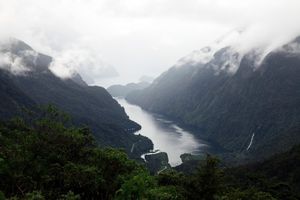Advertisement
Published: January 24th 2012

 Doubtful Sound
Doubtful Sound
In (almost) all its glory.Campervans provide a pleasant combination of new scenery and destinations every day, without having to pack and unpack belongings into bags in order to get there. So it was for us for over three weeks in New Zealand, South and North islands, 3500 km (c.2190 miles) of winding roads and the occasional gravel track.
Before we hit the road, we spent a day or so in what remains of central Christchurch, following massive earthquakes in Sept 2010 and Feb 2011, and subsequent aftershocks. It currently feels like a computer game, where various levels remain inaccessible due to lack of player progress. The player is CERA (Christchurch Earthquake Response Agency), and its role at the moment is the demolition of several multi-storey buildings, that stand like ghostly shells of their former selves, with forlorn curtains blowing in the breeze. The city’s restaurants are relegated to humble take-away stalls, banks, cafes and shops to port-a-cabins. But life goes on…
We weave our way south-west, through meadows, valleys and small towns, over rushing streams and placid rivers. To simply list the amazing landscapes would fill a blog, but not do them justice. It’s not just the natural beauty of the land that
is breath-taking, it’s the diversity of it too. It’s possible to drive over a moor, by a sun-kissed lake, alongside a glacier and into a rainforest, in one afternoon.
The Christchurch earthquakes, the glaciers and many other phenomena remind us that, geologically, New Zealand is the hyperactive teenager, while Australia is the mature adult, set in its ways, its path largely chosen and predictable.
Australia’s long-standing geological inactivity is responsible for its tough, barren landscapes, and the venomous lengths some of its natural inhabitants have had to go to in order to survive and thrive.
In New Zealand, by contrast, the animal and plant worlds had it fairly easy, with rich soils and varied terrain. The animal world had it so easy, in fact, that it hasn’t coped very well at all since the first human settlement, only 1000 years ago.
Prior to this, there were no land mammals on New Zealand. (This may be obvious to the enlightened reader, but wasn’t to us.) Free from canine and feline harassment, flightless birds filled the ‘traditional’ role of the small quadrupeds. So we felt less distraught than we would otherwise at sight of frequent but mainly mammal
road-kill.
If Australia was an ecological abnormality, a freak show, New Zealand was a highly controlled experiment – a non-mammalian alternative. Until Polynesians and latterly, Europeans, came along and rather messed things up.
So while all one has to do in Australia is leave the city for a short while to see kangaroos, crocs and koalas (for the sake of argument, let’s ignore the species we’ve made extinct), in New Zealand one has to look harder to see uniquely indigenous creatures. Harder than we managed anyway.
We did knowingly see one rare indigenous bird, albeit not flightless – the kea, the world’s only alpine parrot – on a day trip to Doubtful Sound. This isolated waterway, which felt about as far from civilisation as we can imagine, is probably the furthest we’ve ever been from home.
Doubtful Sound is a huge stretch of water on New Zealand’s south west coast, bounded by precipitously inclined impenetrable rock. It feels like an unknown, unchartered prehistoric land. (Indeed, it’s only been discovered and explored in the last 200 years). Aboard the boat we seemed insignificantly small, as we journeyed through several miles and tens of thousands of years of
glacier-hewn history. Water pours from the ridges hundreds of metres above our heads, into the murky waters that reach 400m below our feet. It’s just a drop in the ocean of Doubtful Sounds’ annual rainfall of up to 16m, eight to ten times higher than nearby Te Anua!
Further north, on the North Island in fact, we were able to see even clearer examples of the earth as an evolving entity. Calm Lake Tapau, a popular holiday and leisure spot, is, it transpires, actually the caldera of a dormant volcano. Nearby, at the colourful ‘Hidden Valley’ at Orakei Korako, and the tourist town of Rotura, little separates us from the source of the steam that bubbles through lively mud pools or from the strong smell of sulphur.
That's enough geography from Ben, and enough landscape photography for Mina. The next blog will feature neither...
Advertisement
Tot: 0.146s; Tpl: 0.014s; cc: 21; qc: 93; dbt: 0.1008s; 1; m:domysql w:travelblog (10.17.0.13); sld: 1;
; mem: 1.2mb

 Doubtful Sound
Doubtful Sound
 Strange thermal world at Orakei Korako
Strange thermal world at Orakei Korako
 View of Lake Wakatipu, with The Remarkables in the background.
View of Lake Wakatipu, with The Remarkables in the background.































Mon Haley
non-member comment
NZ
It looks absolutely beautiful. Such a variety of scenery. Once again, fabulous photos. Can't wait to visit NZ sometime soon. (The earthquake was Feb. I remember because it was on my birthday. We visited Judy that day and she was contacting friends to see they were safe.)